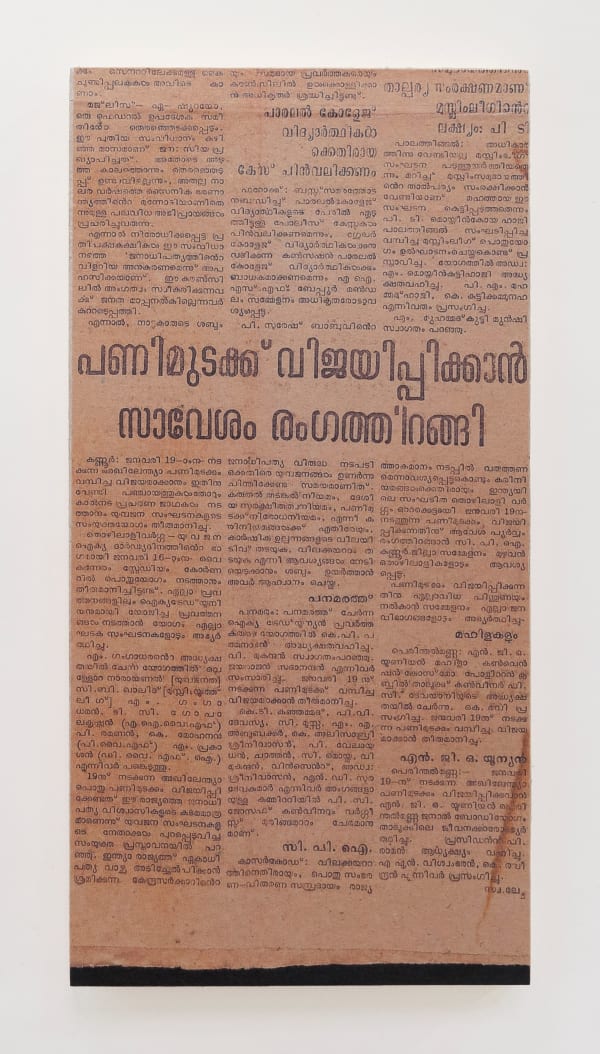-
In December 2017, Divecha chanced upon a projectionist’s block calendar diary among the refuse of the recently decommissioned El Dorado Cinema in Abu Dhabi. First opened in the 1990s on the capital’s Electra Street, the El Dorado initially screened English language films before shifting to largely Mollywood and Tollywood films for South Asian audiences.
-
-
The events captured in the pages of the diary, unassuming and banal, became a springboard from which Divecha not only imagined a persona, but conjured a profound reflectio on alienation, exclusion, and remembrance.
-
-
The resigned poignancy of the diary entries—‘as usual,’ ‘bulb changed today,’ ‘picture stuck, error come’—constituted a departure point for the genesis of a character blurring fact and fiction, an invisible projectionist, named simply ‘K’.
-
-
Borrowing from cinematic conventions of fictionalisation, Divecha renders, through K, an exhibition-as-portrait: even the obviously abstract paintings conspire to sketch out a character who was, by profession, on the margins.
-
-
K’s diaristic documentation of ‘reality,’ scrawled in the calendar pages, is scanned and printed on yellowed sandwich paper and mounted on wood panels evoking the thickness of the desktop block calendar. The entries allude to screenings in the El Dorado’s two halls, the texts peppered with film titles and references to regional languages—Tamil, Telugu, or Malayalam (K’s native tongue, since he hails from Kerala).
-
-
El Dorado includes a series of excerpts from a fictionalize screenplay, locating K specifically within the very idiom of cinema. These outtakes, screen printed white on inky black paper point at once to the sombre dwellings in which the projectionist passed his days. Assembled from informal conversations with El Dorado employees, an invisible personage is evoked, emerging from fragments of memory and invented figments. Considered together, the diary pages and screenplay excerpts function as a portraiture of absence.
This absence is further confounded by The League Times Daily 1982 January 12 (2022), a work stemming from Divecha’s research with archivists to study activism in the 1980s in the north of Kerala, K’s original home
-
-
Unsurprisingly, K’s diary is punctuated by scribbles - marks, marginalia, and doodles, rendered unconsciously, at those moments of suspended time. For Divecha, these scribbles began to echo the writings of Marx on the alienation of labour - where he states that workers being subsumed in a cycle are rendered directionless, impotent.
-
-
In the Aimless Calligraphy paintings, the directionless scribbles are juxtaposed with very purposeful beams of cinematographic light penetrating the space. This juxtaposition intensifies when we consider the typical scenes of hyper-masculinity which pepper South Asian cinema—determined protagonists enacting their wills to triumph, masters of their fate (for a few hours life is at odds with fatalism {often ascribed to Hinduism}, where higher powers steer the outcomes of believers’ existences).
-
-
Yet the paintings also suggest a movie-goer’s state of mind, one of suspension, fantasy and escape. Colours are modulated by layers of glazing which allows light to filter through the translucent paint and create an effect of soft glow. Like the cinema, the paintings entangle light and colour in a work of seduction.
-
-
 Vikram Divecha, Untitled Scene (Aimless Calligraphy, August 3), 2022
Vikram Divecha, Untitled Scene (Aimless Calligraphy, August 3), 2022 -
 Vikram Divecha, Untitled Scene (Aimless Calligraphy, March 2), 2022
Vikram Divecha, Untitled Scene (Aimless Calligraphy, March 2), 2022 -
 Vikram Divecha, Untitled Scene (Aimless Calligraphy, September 10), 2022
Vikram Divecha, Untitled Scene (Aimless Calligraphy, September 10), 2022 -
 Vikram Divecha, Untitled Scene (Aimless Calligraphy, August 3), 2022
Vikram Divecha, Untitled Scene (Aimless Calligraphy, August 3), 2022 -
 Vikram Divecha, Untitled Scene (Aimless Calligraphy, June 30), 2022
Vikram Divecha, Untitled Scene (Aimless Calligraphy, June 30), 2022 -
 Vikram Divecha, Untitled Scene (Aimless Calligraphy, July 22), 2022
Vikram Divecha, Untitled Scene (Aimless Calligraphy, July 22), 2022
-
-
-
ABOUT THE ARTIST
Beirut-born, Mumbai-bred, Vikram Divecha is an artist based in Dubai. He holds an MFA in Visual Art from Columbia University and was a participant of the Whitney Museum’s Independent Study program. Divecha’s practice shifts between public art, site-specific interventions, installation, film, painting, drawing, photography, and text. His practice raises questions about time, value and authorship by engaging people across urban and social spheres and working with available material and space. Divecha terms this approach as ‘found processes’, which often sees him intervene within public and social systems. From wholesale exporters to municipal gardeners, architectural consultants to railway traffic managers, Divecha’s participants inform and shape his projects in various ways, at times for sustained durations. His ambitions new 34-minute film Dohrana (2021) commissioned by Warehouse 421 continues his collaboration with Sharjah’s municipal gardeners, exploring Urdu poetry, choreographic postures, movements and music within the ever-green aesthetics of urban landscaping and traffic islands. Divecha teaches as an Adjunct Professor at AUS (American University of Sharjah) in the College of Architecture, Art and Design.
Exhibitions include: Portrait of a Nation II, Manarat Al Saadiyat, Abu Dhabi (2022); Sharbaka: Entanglement/Attunement, 19 WSN, New York (2021); On Foraging, Expo 2020, Dubai (2021); Conjuncture, The Elizabeth Foundation for the Arts, New York (2020); Towards Opacity, Gallery Isabelle van den Eynde, Dubai (2020); Second Hand, Jameel Arts Center, Dubai (2019); Living Room: UIT (Use it together), ISCP, New York (2019); Rock, Paper, Scissors: Positions in Play, National Pavilion UAE, 57th Venice Biennale (2017); Tamawuj, Sharjah.


















